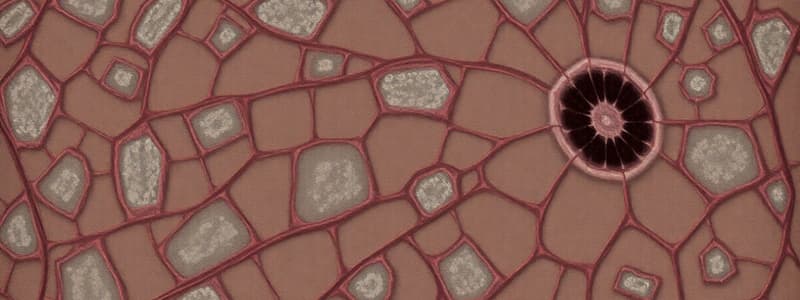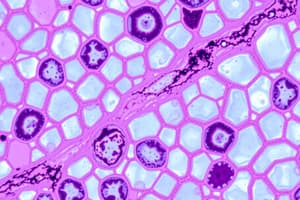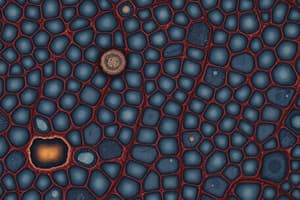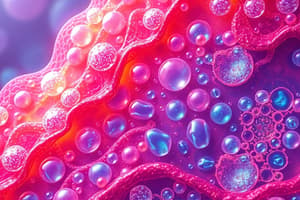Podcast
Questions and Answers
What is a primary function of epithelial tissue?
What is a primary function of epithelial tissue?
- Support
- Movement
- Secretion (correct)
- Conducting nerve signals
What characteristic does epithelial tissue possess that allows it to fit closely together?
What characteristic does epithelial tissue possess that allows it to fit closely together?
- Continuous sheets (correct)
- Presence of blood vessels
- Vascularity
- Interspersed organ structures
Which type of epithelial cell shape is described as 'cubes'?
Which type of epithelial cell shape is described as 'cubes'?
- Columniform
- Squamous
- Cuboidal (correct)
- Columnar
Which of the following is NOT a function of epithelial tissue?
Which of the following is NOT a function of epithelial tissue?
What feature describes the underside of epithelial cells?
What feature describes the underside of epithelial cells?
Which type of epithelial tissue is best suited for filtration and absorption?
Which type of epithelial tissue is best suited for filtration and absorption?
What type of epithelial tissue consists of multiple layers of cells?
What type of epithelial tissue consists of multiple layers of cells?
How does epithelial tissue receive nourishment?
How does epithelial tissue receive nourishment?
What does the term 'apical surface' refer to in epithelial tissue?
What does the term 'apical surface' refer to in epithelial tissue?
Which is NOT a type of epithelial tissue based on cell shape?
Which is NOT a type of epithelial tissue based on cell shape?
What is the primary function of simple cuboidal epithelium?
What is the primary function of simple cuboidal epithelium?
Which type of epithelium is characterized by elongated cells with nuclei at the same level?
Which type of epithelium is characterized by elongated cells with nuclei at the same level?
Where is pseudostratified epithelium predominantly found?
Where is pseudostratified epithelium predominantly found?
What feature is unique to simple columnar epithelium that enhances its function?
What feature is unique to simple columnar epithelium that enhances its function?
What distinguishes stratified squamous epithelium from other types of epithelial tissue?
What distinguishes stratified squamous epithelium from other types of epithelial tissue?
What is the main function of transitional epithelium?
What is the main function of transitional epithelium?
Which glands release their secretions directly into the bloodstream?
Which glands release their secretions directly into the bloodstream?
Which of the following structures are associated with pseudostratified epithelium?
Which of the following structures are associated with pseudostratified epithelium?
Which location is primarily associated with simple cuboidal epithelium?
Which location is primarily associated with simple cuboidal epithelium?
What is a characteristic of stratified cuboidal epithelium?
What is a characteristic of stratified cuboidal epithelium?
Flashcards
Epithelial Tissue
Epithelial Tissue
Groups of similar cells forming continuous sheets that cover and line body surfaces and cavities.
Tissues
Tissues
Groups of cells similar in structure and function.
Epithelial function-Protection
Epithelial function-Protection
Epithelial tissues form a barrier protecting underlying tissues from pathogens and harm.
Epithelial function-Absorption
Epithelial function-Absorption
Signup and view all the flashcards
Epithelial function-Filtration
Epithelial function-Filtration
Signup and view all the flashcards
Epithelial function-Secretion
Epithelial function-Secretion
Signup and view all the flashcards
Simple Squamous Epithelium
Simple Squamous Epithelium
Signup and view all the flashcards
Apical Surface
Apical Surface
Signup and view all the flashcards
Basement Membrane
Basement Membrane
Signup and view all the flashcards
Avascularity
Avascularity
Signup and view all the flashcards
Simple Cuboidal Epithelium
Simple Cuboidal Epithelium
Signup and view all the flashcards
Simple Columnar Epithelium
Simple Columnar Epithelium
Signup and view all the flashcards
Pseudostratified Epithelium
Pseudostratified Epithelium
Signup and view all the flashcards
Stratified Squamous Epithelium
Stratified Squamous Epithelium
Signup and view all the flashcards
Transitional Epithelium
Transitional Epithelium
Signup and view all the flashcards
Endocrine Glands
Endocrine Glands
Signup and view all the flashcards
Exocrine Glands
Exocrine Glands
Signup and view all the flashcards
Stratified Cubodial Epithelium
Stratified Cubodial Epithelium
Signup and view all the flashcards
Basement Membrane
Basement Membrane
Signup and view all the flashcards
Cilia
Cilia
Signup and view all the flashcards
Study Notes
Tissue Introduction & Epithelial Tissue
- Human bodies develop from single to multicellular, cells specialize.
- The body is an interdependent system, failure of even one group of cells can be catastrophic.
- Cells become tissues, then organs.
- Tissues are groups of cells with similar structure and function.
Types of Tissues
- Epithelium: Coverings & linings of surfaces
- Connective: Support (bone, ligaments, fat)
- Muscle: Movement
- Nervous: Control (brain, nerves, spinal cord)
Function of Epithelial Tissue
- Protection: Skin protects from sunlight, bacteria, & physical damage.
- Absorption: Lining of small intestine absorbs nutrients into blood.
- Filtration: Lining of kidney tubules filters wastes from blood plasma.
- Secretion: Glands produce perspiration, oil, digestive enzymes & mucus.
Characteristics of Epithelial Tissue
- Forms continuous sheets (like tiles).
- Apical Surface: Top surface of cells bordering an open space (lumen).
- Basement Membrane: Underside of epithelial cells, anchoring them to connective tissue.
- Avascular: Lacks blood vessels, nourished by connective tissue.
- Regenerates quickly.
Classification of Epithelial Tissue
- Cell Shape: Squamous (flattened like fish scales), Cuboidal (cubes), Columnar (columns)
- Cell Layers: Simple (one layer), Stratified (many layers).
- Naming is based on the cell type at the apical surface.
Simple Squamous Epithelium
- Structure: Single layer of flattened cells.
- Function: Absorption & filtration. Less protection due to single cell layer.
- Location: Walls of capillaries, air sacs in lungs, and forms serous membranes in body cavities.
Simple Cuboidal Epithelium
- Structure: Single layer of cube-shaped cells.
- Function: Secretion & transportation in glands, filtration in kidneys.
- Location: Glands and ducts (pancreas & salivary), kidney tubules, covers ovaries.
Simple Columnar Epithelium
- Structure: Elongated layer of cells with nuclei at same level.
- Function: Absorption, protection, secretion. Forms mucous membranes when open to body cavities.
- Special Features: Microvilli (increase surface area & absorption), goblet cells (produce mucus).
- Location: Linings of entire digestive tract.
Pseudostratified Epithelium
- Structure: Irregularly shaped cells with nuclei at different levels—appear stratified, but all cells reach the basement membrane.
- Function: Absorption & secretion. Goblet cells secrete mucus, cilia sweep mucus.
- Location: Respiratory linings & reproductive tract.
Stratified Squamous Epithelium
- Structure: Many layers, typically cuboidal or columnar at bottom with squamous at top.
- Function: Protection. Keratin (protein) hardens & waterproofs skin.
- Location: Skin (keratinized), mouth, & throat.
Transitional Epithelium
- Structure: Many layers, specialized cells that change between stratified & simple forms based on tissue stretching. Cells at base are cuboidal or columnar; surface cells vary.
- Function: Allows stretching (size change).
- Location: Urinary bladder, ureters, & urethra.
Glands
- Single or multiple cells producing & secreting products.
- Secretion: Protein in aqueous solution (e.g., hormones, acids, oils).
- Endocrine: No ducts, release secretions into blood vessels (e.g., hormones, thyroid, adrenal & pituitary).
- Exocrine: Contain ducts, empty onto epithelial surface (e.g., sweat, oil, salivary, mammary).
Shapes of Exocrine Glands
- Branching: Simple (unbranched duct) vs. Compound (branched).
- Shape: Tubular (tube-like) vs. Alveolar (flask or sac-like). vs. Tubuloalveolar (both).
Modes of Secretion
- Merocrine: Exocytosis, no gland alteration. (e.g., sweat & salivary glands)
- Holocrine: Gland ruptures, releasing secretion and dead cells. (e.g., sebaceous oil glands)
Studying That Suits You
Use AI to generate personalized quizzes and flashcards to suit your learning preferences.




